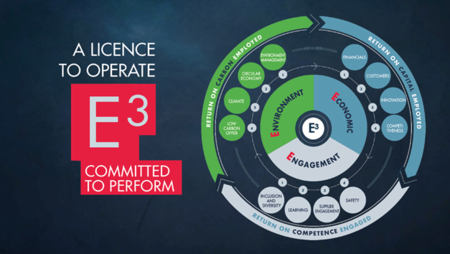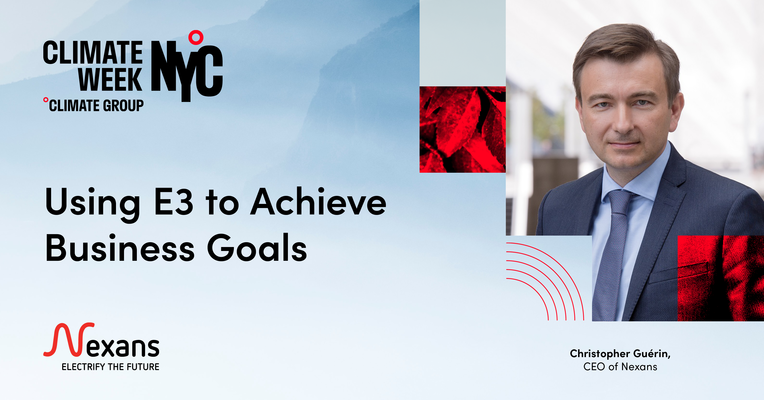ESG has become a buzzword in the global business community and caused a paradoxical shift in how investors, business leaders, employees and consumers evaluate companies – most notably now including how a company is performing relative to its sustainability goals.
Today’s world faces new problems ranging from pandemics and climate change to the shortage of raw materials and global instability. We are in a world of permacrisis, and everything is changing quickly.
While financial metrics are easy to identify in relation to these external factors, business leaders must begin to plan for the long haul and consider new ways to approach business to continue thriving among the next generation of decision makers.
The current norm is to evaluate a company in silos - financial, social, environment, temporal, etc. However, this way of thinking does not maximize a company’s potential and must be changed to future proof the business and it’s a way to be prepared for the world of tomorrow. At Nexans, we have adopted E3. This model shifts our focus to the economy, environment and employee commitment holistically and helps us achieve our goals to create a more sustainable future.

Economy
Environmental and social pressure combined with the pressure to generate profits in a world where growth is restricted by raw materials and resources: therein lies the main challenge. Executives are now focused on the creation of value without volume growth and need to answer the following equation: How can my company increase its profits while maintaining volume and fixed costs all while reducing its carbon footprint?
Many believe the more customers and greater volumes lead to more profits, but that is not always the case and this can accelerate financial losses for some companies. For example, Nexans served 17,000 customers and 300,000 product references in 2019, but the company is able to achieve the same turnover by only serving 4,000 customers and reducing products by 30% in 2022, ultimately shedding 13,000 customers and 90,000 products in less than three years. This counter-intuitive process of letting go of the majority of our customers and some of our products and services enabled us to increase our Return on Capital Employed from 9% to 29% and free up 20 years of historic cash generation. Ultimately this is due to a higher focus on value both on our end and on the customer side. We are still growing with less customers, and it’s important to define growth in a way that is more holistic instead of just focusing on economic growth.
Environment
The upcoming generation of talent is making climate change one of their key markers when choosing employer brands. In order to attract new talent, companies will have to adapt to their needs and focus more of their resources on building a cohesive strategy surrounding sustainability. Human resource departments are scrambling to meet the needs of the upcoming generations by having clear answers on a company’s carbon footprint. Unfortunately, many of these leaders that are hiring these new generations are not trained on sustainability topics and are therefore not equipped to pass on the knowledge to future leaders.
The climate crisis is here to stay and it is urgent that we reimagine the education system from the ground up, from apprenticeship to new hires with the environment at the core. This will allow for a greater understanding of climate matters in future leaders and will result in more specific actions being taken to tackle climate change instead of greenwashing and “high level” actions that don’t result in concrete decision making.
Industry currently accounts for 20% of the problem of global warming and we have the ability to provide 80% of the solution. We need to not only look for key performance indicators (KPIs) that are economic in nature, but also those that are environmental. We need to start as early as tomorrow in qualifying growth per ton manufactured and make changes that are clear and measurable. For example, at Nexans, we were able to lower our carbon footprint efficiently by doing something as simple as installing solar panels on the roofs of some of our factories. While there are good intentions in something like carbon taxing on making positive change, it is not without consequences and there are clear inconsistencies in their application such as the fact that the text identifies certain sectors as eligible, but not others. For example, the production and sale of cables is not taxable under the system, but the installation is taxable. Unfortunately this and other inconsistencies can lead to unintended consequences that outweigh the problems they are trying to solve.
We need to encourage the companies that are trying to solve the problem instead of creating roadblocks. In order to do this, changes need to happen and a culture of accountability must be instilled within the market. We need to stop looking at the environment only as a CAPEX point of view and start looking at it more holistically.
Engagement
The amplification of digital technology gives companies the impression that they are modern, when in fact our organizational and management foundations remain archaic. Despite the COVID-19 pandemic expediting remote work and increasing digital usage among teams, our organizations still rely on disparate and outdated systems that divide more than they unite.
Companies generally remain pyramid-like in structure, their rules and procedures have multiplied and, for years, we have been emphasizing the expertise of functions even more, thus amplifying silos. The modern workforce is becoming increasingly complicated: the immediacy of information, reduced purchasing power and accumulating crises are muddying the waters, causing both general fatigue and a deepening of inequalities. At once volatile and complex, our environment is also becoming unpredictable. How, then, can we give meaning to the uncertainty, and generate positiveness in daily business life?
While employees continue to be asked to equate work with a purpose such as the need to provide for themselves, or emancipation, we will continue to feed negative attitudes concerning work in our collective thinking. And this is normal and perfectly natural. Helping people understand work as an essential tool that serves an endeavor and a shared ambition requires a great deal of thought and commitment on the part of the top management who must then craft a shared vision, a collective endeavor that everyone can understand, become involved in, and identify with.
Managers are made up of the “knowers” and the “learners”. Today’s world needs people with dexterity, with the ability to question their own actions, with intuition and adaptability, endowed with a long-term vision – in other words, we need more “learners” and less “knowers”. Lifelong learning is essential to creating a strong company culture, collectively evolving as employees or managers. By focusing on development, companies can ultimately retain talent and remain profitable.
We believe that E3 can make an impact and hope companies will join our movement to drive the transition. The problem is simple to solve at its core, with no need for new technology or laws. It only requires us to use a new model that takes into account a more holistic view of business. Companies and governments alike must work together to secure the future, and we need to work quickly.
